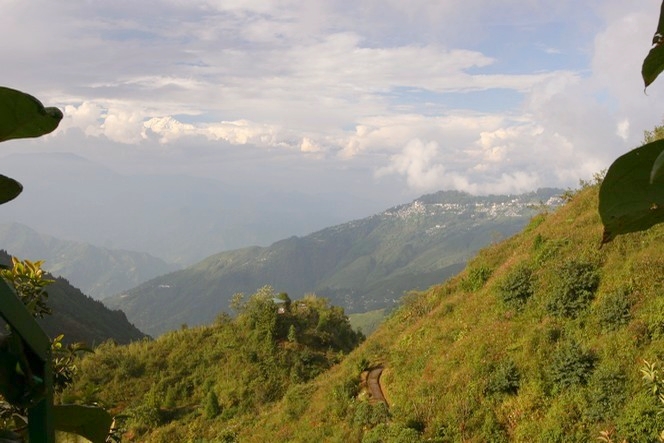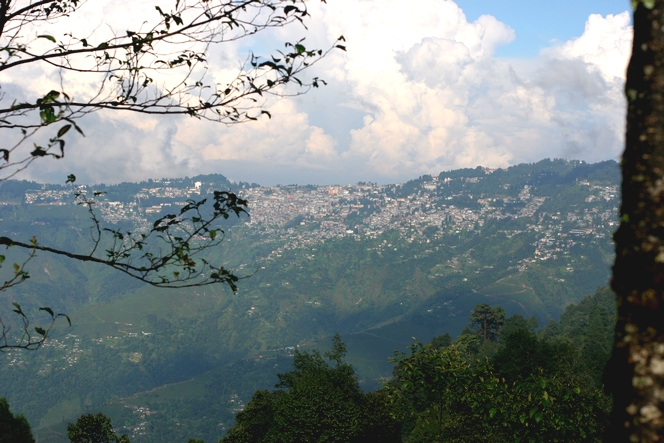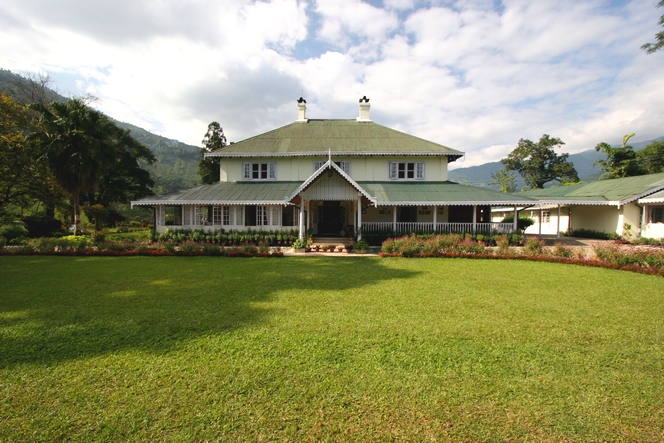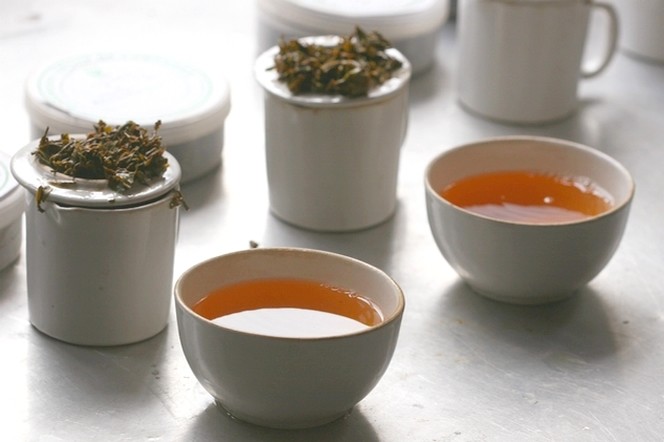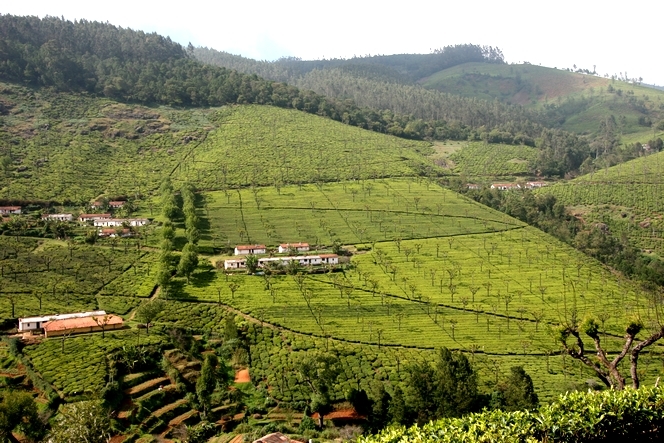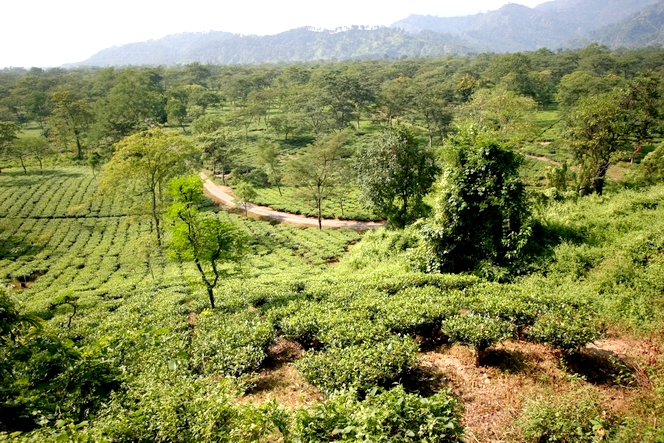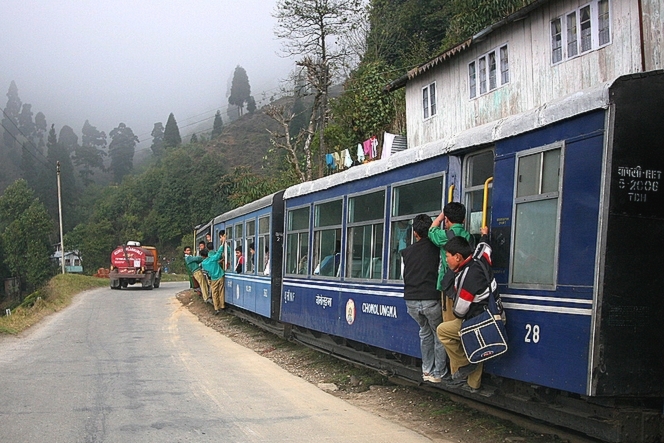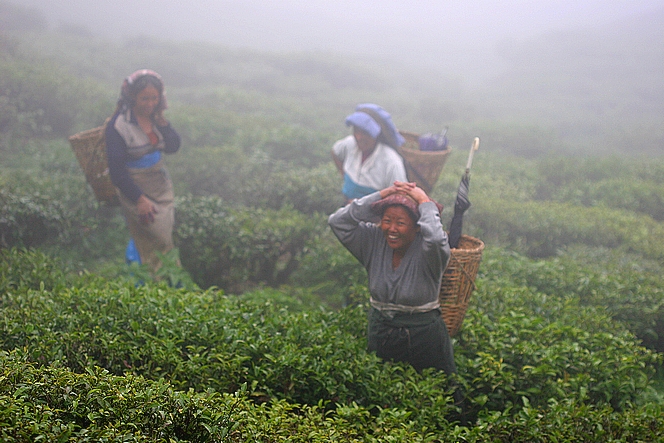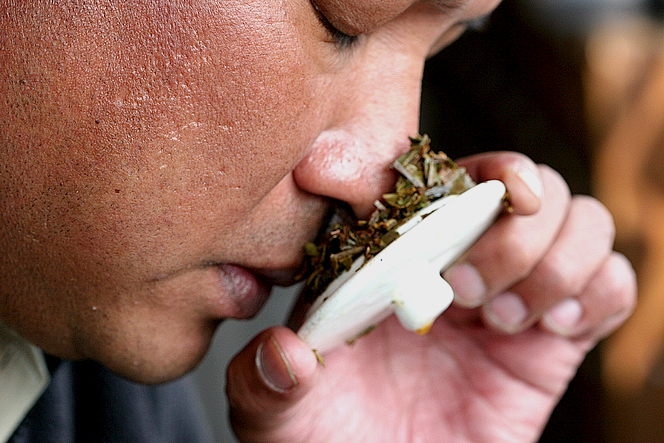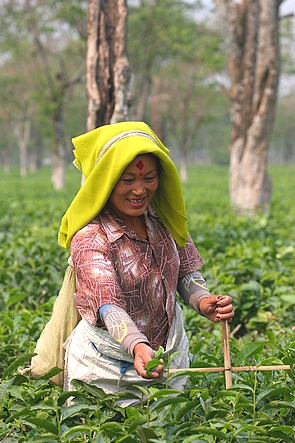You have to admit that Darjeeling’s urbanization was very quick and not very well under control. As a result, noise, traffic jams, a lack of water and a waste management not very much enviable. But a few meters further, nature takes up and you come across breathtaking landscapes. Here I’m looking towards the West at these mountain folds forming what we call the Himalayan foothills. They’re not considered to be high mountains yet, but if you look well between the clouds, if you’re observant, you might notice this magnificent peak: let me introduce you, Ladies and Gentlemen, the third highest peak in the world, the Kanchenjunga!
India
Darjeeling or “the stormy country”
“Darjeeling” both refers to the tea plantations stretching out on thousands of hectares and the city you can see on this picture and where from I’m writing to you today. It’s a large town of hundreds of thousands people, or, in other words, a village on an Indian scale. It’s located at an altitude of 2100 meters and here you can see it under a rather mild sky if you consider that in Tibetan “Darje Ling” means “the stormy country”. The city is on a slope and when you walk around it, you actually spend more time climbing the narrow stairs snaking in and out the houses than crossing leaning streets. Tea is all there is, to such an extent that people don’t know where to build houses anymore, yet necessary to provide accommodation for an increasing population.
In Tumsong Tea Estate : a wonderful bungalow
I’m leaving for Darjeeling in a few days. A long trip, hours of plane and four wheel drive. But I go through these hours smoothly as I’m so happy to see these mountains again. Once a year I take with me several people working for Le Palais des Thés. This year Fabienne, in charge of Le Palais des Thés in Lille, Stéphanie from Grenoble, Maud from Paris’ rue-Vieille-du-Temple are coming with me among others. I’ll soon introduce them to you.
We are first staying at Tumsong Tea Estate, an organically certified tea plantation of Darjeeling which has such a British cottage (photo) ! It’s a real pleasure to live in such a great house, nestled in the mountains as it is and exquisitely comfortable. All the more so as Rajiv Gupta, the plantation’s manager, keeps an eye on everything and is very concerned of your well-being. We visit his property together, from the factory to the nursery, without forgetting the river’s edge where it’s nice having a picnic.
These very British cottages are very common in Darjeeling: in each plantation the manager has a similar building, only the size and the style sometimes differ. You can easily stay there in Tumsong if you wish to as contrarily to most plantations, here tourists interested in tea are welcome for one or several nights (www.chiabari.com).
We are also thinking of organizing classes included in Tea School program. Anyone interested?
In Barnsbeg like elsewhere, I take the time for tea
Once the tea is infused you have a wait a little bit of time before enjoying it. I grab this opportunity to smell the wet tea leaves and look around the tasting room flooded with northern light. While in the teacup the temperature goes from the infusion temperature (around 85 – 90 degrees for a black tea) to the tasting temperature (around 50 degrees), I take out my camera and turn around the teacups searching for the best possible angle. There’s no hurry here in Barnsbeg (India), life goes on slowly. I take a picture of the tasting set just for the pleasure of capturing a shimmer or a colour, a shadow or a line on the teacup’s surface. And my thoughts go on drifting, just like a travelling wave.
This is call taking time. The time for tea, simply.
Tea plantations form small villages
Some tea plantations run by the British are so vast that several thousand people can live there, scattered across several hundred hectares. In southern India, like here in Thiashola, groups of buildings are home to one, two or three families. These houses form small villages where social life plays an important role. Although the buildings belong to the plantation, they are made available to the families as long as they work on the land. So this means that most houses are handed down from generation to generation.
A beautiful landscape doesn’t always make a good tea
A beautiful landscape doesn’t always make a good tea. When I come from Bagdogra (India) and start the three-hour ascent into the Himalayan foothills, I love nothing more than stopping and admiring the view once I get through the stifling heat of Siliguri. The land is no longer completely flat, the city has disappeared from sight, the traffic and the horns have calmed down. Goats doze on the roadside. You start seeing far away above the trees and it helps bearing the heat: you suffocate much less when looking at a clear view. With the gentle breeze and the smell of the earth, I always stop walking between the tea plants.
Actually, I must say that they’re not good tea plants. People say that they are Darjeelings, but it’s not quite true: they are just outside the Darjeeling “appellation”, but close enough for dishonest merchants to use them to bulk out the real Darjeelings and cheat the buyers. This explains how there is four times as much Darjeeling tea sold worldwide than is actually produced.
Never mind, it’s the landscape that is worth admiring here. It is truly magnificent. I’m really attracted to this Terai plain, which used to be a jungle until the British cut down all the trees. People say you sometimes see wild elephants charging around and leopards. I feel good here, so I walk and walk before continuing on my way to Darjeeling. Why beeing in a hurry when it’s so beautiful around?
On the way to school in Kurseong
Almost the beginning of the new school year ! In Kurseong (India), these schoolboys jump on the Toy Train’s bandwagon and hold on the outside, not because the train is packed, but simply because it’s actually more fun doing the journey with the head in the breeze.
They laugh, say hello to the people they know when the train crosses a village: a pleasant way to get to school.
Tea pluckers in the mist of Badamtam
In the middle of summer, a bit of freshness is always welcome. Like this refreshing mist coming from the foothills of the Himalayas. People there are so used to living in the clouds that this humidity is part of their life and no-one pays any attention to it. It’s actually not unpleasant, just look at the faces of these tea pluckers and you’ll see that no-one seems depressed by it. They look like they’re having fun, in fact.
This is at Badamtam, a magnificent plantation located in the north of Darjeeling, across from Sikkim.
Just a detail: do you see the umbrella in the basket? Well, it is actually used when the sun comes out, to provide shade and keep a nice complexion.
To choose tea, you need to have a good nose
When you taste tea, you first start by smelling it. This is a very important stage in the tasting process. You look at the infused leaves, inhale them and by doing so you already get lots of information on the tea. You could for example easily detect problems such as an over-drying, an overly long oxidization process if it’s black tea, or inappropriate fermentation. But of course it also allows you to identify the qualities of the tea and the different scents you could find again in the cup in more or less similar ways.
It’s only after smelling the infused leaves (what is called “infusion” in the trade) that we actually taste the liquor itself.
Here, in Badamtam (Darjeeling), Binod Gurung has his eyes closed. His nose is plunged in the damp, warm leaves. He inhales, analyses, all in a state of complete concentration.
Cheerful plucker looking like a tea missionary
On the Terai plain (area straddling Nepal and India), I’ve seen them use strange crosses to mark the height of tea plants. The cross is stuck into the ground and only the shoots growing above the horizontal bar are plucked. It makes this cheerful plucker look a bit like a tea missionary.

